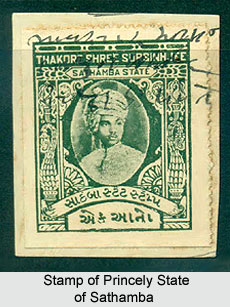 The Princely State of Sathamba was amongst Indian princely states during the rule of the British Empire in India. During the early 19th century, the region was appointed as one of the princely states of India under the indirect rule of the British administration. The region was scattered over a total area of 18 sq miles and comprised of a total population of 4,634 in the year 1931. Sathamba state was situated is in the southeast corner of the division of Sadra and included around 22 villages. The territory was bordered by the regions of Lunawada and Balasinor in the east; by Idar, Balasinor and British India in the south; by territories of British India in the west; and by Idar and other districts of British India in the north. The erstwhile princely state of Sathamba was incorporated as a part of the Baroda Agency, which was a sub division of Western India States Agency. The territory was also a part of the former Sabar Kantha Agency, as well as the Sadra Division. Later the region of Sathamba was merged with the state of Gujarat.
The Princely State of Sathamba was amongst Indian princely states during the rule of the British Empire in India. During the early 19th century, the region was appointed as one of the princely states of India under the indirect rule of the British administration. The region was scattered over a total area of 18 sq miles and comprised of a total population of 4,634 in the year 1931. Sathamba state was situated is in the southeast corner of the division of Sadra and included around 22 villages. The territory was bordered by the regions of Lunawada and Balasinor in the east; by Idar, Balasinor and British India in the south; by territories of British India in the west; and by Idar and other districts of British India in the north. The erstwhile princely state of Sathamba was incorporated as a part of the Baroda Agency, which was a sub division of Western India States Agency. The territory was also a part of the former Sabar Kantha Agency, as well as the Sadra Division. Later the region of Sathamba was merged with the state of Gujarat.
History of Princely State of Sathamba
The Baria Kolis was the ruling family of the princely state of Sathamba. The family was originally from the territory of Sind and was barred by Muslim invaders from Patdi in the late 13th century. They took refuge from the Raja of Champaner, who was a Rajput. He granted the region of Baria to them as a jagir. From Baria, the family gained possession of the state of Sathamba. Succession of the throne of the former princely state was governed by the rule of male primogeniture.
The native ruler of the princely state of Sathamba held the official title of Thakor. The Thakor of Sathamba state was ranked in the Fifth Class amongst the rulers of Mahi Kantha before the abolition of classes in the year 1928. He exercised limited civil and criminal jurisdiction over the state and supervised the administration of the entire territory. The erstwhile native state of Sathamba paid annual tribute to Lunawada, Balasinor and Baroda. Under the Attachment Scheme of 1943, the princely state of Sathamba was attached to the princely state of Idar. It was one of the 29 units attached in the first stage of the scheme which followed the lead of Ghodasar and Bhadwa in declining to identify the authority of the states attached.
Sathamba was one of the princely states of Bombay until the independence of India with under the reign of Thakore Shree Sursinjee and Thakore Shree Ratansinhji. The princely state minted its own coinage and currency in the forms of Aana and Rupee. After the withdrawal of the British administration and the partition of India in the year 1947, the last ruler Thakore Saheb Sursinhji Ratansinhji on Sathamba acceded his state to the newly formed Union of India, also known as Dominion of India in 1948.
Rulers of Princely State of Sathamba
The chronology of the native rulers of the princely state of Sathamba are discussed as follows-
* Thakore Saheb Sardarsinhji (1840- 1867)
* Thakore Saheb Ajabsinhji (1867- 1895)
* Thakore Saheb Vijaysinhji (1895- 1918)
* Thakore Saheb Ratansinhji (1918- 1941)
* Thakore Saheb Sursinhji Ratansinhji (1941- 1948)
* Thakore Saheb Indravijaysinhji Sursinhji



















